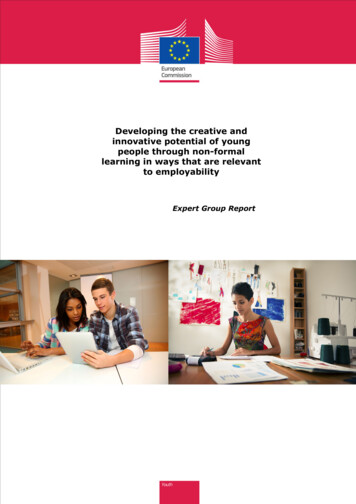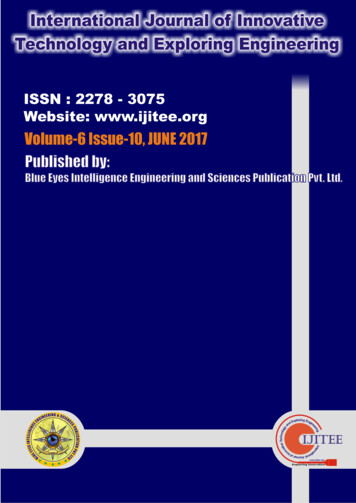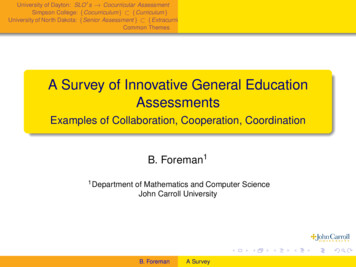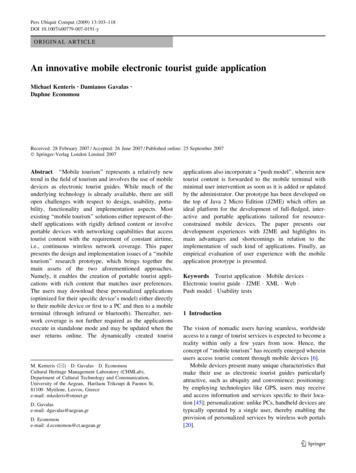
Transcription
Developing the creative andinnovative potential of youngpeople through non-formallearning in ways that are relevantto employabilityExpert Group ReportNovember 2013May 141
Towards aFramework forActionThere is a need to recognise and value non-formal learning in acreative and innovative way, raising the visibility of skills acquiredoutside the formal system and fostering complementarity betweennon-formal and formal learning, while at the same time promotingequal opportunities.Rethinking Education, 20.11.2012, COM (2012) 669The report was prepared for the Youth Working Party, Council of the EU, by Dr JohnBamber (Centre for Effective Services, Ireland) with the assistance of the Commissionand expert group members.May 142
ForewordIn a context of record levels of youth unemployment in Europe, this report is about hownon-formal learning and especially youth work can enhance the creative and innovativecapacities of young people in ways that are relevant to employability. It goes beyondidentifying the skills and competences involved, to present illustrative examples ofpractice and cross-sectoral cooperation. In arguing that investment in non-formallearning pays economic and social dividends, it is important to keep in mind that youngpeople are more than just a potential workforce, and should not be perceived only in thecontext of their situation in the labour market.Among young people are potential philosophers, artists, writers, entrepreneurs,craftsmen and women – people who will create, who will constitute, who will continueEurope’s culturally rich and unique traditions. Although support is needed in the currentsituation, it is also an investment in Europe’s human and cultural capital. The argument,therefore, is not about changing young people because their alleged lacking is the causeof unemployment. Instead the emphasis is on their potential contribution toimprovements in social and economic conditions.The main message is about the need to improve and widen the recognition of non-formallearning, and not just in relation to employability. A better equipped workforce isrequired; one that can interact effectively with young people, especially those who aredisadvantaged and lack access to the jobs market. The workers need an improvedcurriculum, and an investment in training, to stimulate the innovative and creativecapacities within young people. They need access to commonly accepted recognitiontools and to improved practices that can be used in their own social and culturalcontexts. At all levels, the different sectors and stakeholders need to come together toprovide a supportive environment for the work, while incentives and initiatives need togalvanise the social partners for effective interaction.This report reflects the commitment of the Expert Group, whose members come from awide variety of backgrounds, representing a wealth of experience and expertise. The keymessages and recommendations are the result of a rigorous evidence-informed processwhich sought to critically examine policy, whilst drawing from the latest research andexamples of practice.Dr John BamberChair of the Expert GroupMay 143
Table of ContentsExecutive summary5Towards a framework for action8Introduction8The situation of young people10The policy response11Youth work outcomes and the requirements of the labour market15Research underpinnings for innovation and creativity18The contribution of youth work19Current tools to support non-formal learning19Illustrative practices20Key messages23Recommendations27Conclusion and next steps34Bibliography36Appendices41Appendix 1: Glossary of key terms41Appendix 2: Skills for the future labour market45Appendix 3: Outcomes and indicators in youth work46Appendix 4: Methodology of the working group47Appendix 5: Expert group on peer learning list of representatives50List of Tables and FiguresFigure 1: Distribution of unemployed young people in Europe10Table 1: Correspondence between skills in youth work and the labour market17Table 2: Illustrative practices leading to enhanced capacities forinnovation and creativity21Figure 2: Elements of a framework for enhancing innovation and creativity23Table3: Developing different types of competence24Figure 3: Developing partnership between sectors25May 144
Executive summaryThe attention of policy makers at European, national, regional and local levels is nowfirmly focused on the fact that the total of young people not in employment, education ortraining, is currently around 14 million in the EU. At the European level the policyresponse takes the form of programmes such as Erasmus , and funding streams suchas the Youth Employment Initiative (2013). The Council and the Commission have alsoproduced a stream of papers and pronouncements providing direction for developmentsin Member States, who need to act in ways that are consistent with their own traditionsand socio-economic position. In general, there is a great deal of knowledge about theproblem, with less about how to resolve it.It is recognised that the situation of young people is not uniform, with wide variations inthe levels of youth unemployment between Member States. Even within Member Statesparticular social groups are more likely to suffer the consequences of unemploymentthan others, and there is a need to focus on the disadvantaged and those furthest fromthe labour market.The contribution of non-formal education and learningNon-formal education and learning has an important role to play in responding to youthunemployment. This is because it supports development by helping to transform youngpeoples’ potential, creativity, talents, initiative and social responsibility, through theacquisition of related knowledge, skills, attitudes and values. It is often communitybased and outside of formal institutional contexts.Youth work can play a key role in reaching out to all young people. For those with feweropportunities, youth work supports re-integration, through its close and informalcontacts with young people, youth-friendly outreach and ability to instil trust in youngpeople to get in touch with authorities. It provides individual support on occupationalorientation and counselling, tailored to the particular challenges of different youngpeople, in an informal environment.The purpose of youth work is not to provide jobs but engagement in the wide variety ofpersonal and social development activities that it offers, helps young people to developthe knowledge, skills, and attitudes that are frequently said to be needed in the labourmarket. These include teamwork, communication, leadership, flexibility andresponsiveness. They also include creativity and innovation, which involve definingproblems, coming up with ways of dealing with them, and sticking to a chosen course ofaction. In this way youth work contributes to closing the gap between the competencesacquired by young people and the needs of the labour market.Although its value is recognised at policy levels, non-formal learning is not widelyunderstood, and it is often well down the list of priorities when it comes to funding. Thissituation needs to be redressed by a concerted effort from the social partners, and fromstakeholders at all levels.An integrated approachSystematic, sustained and concerted action is required to significantly enhance thecreative and innovative capacities of young people in ways that are relevant toemployability. The Expert Group recommends actions in the following areas:May 145
1. Explaining non-formal learning to employers and educatorsIt is essential to increase the recognition and validation of non-formallearning in business contexts and in the total education sector. This will helpproviders, young people and potential employers to appreciate the learningand development that occurs. Recognition of non-formal learning is a crucialobjective of Erasmus . It is important to understand that the wide range ofcompetences gained are not limited to so called ‘soft’ skills, and todemonstrate how they contribute to innovation and creativity –2. Translating non-formal learning outcomes to the world of workThere is a need to promote the validation of learning outcomes gained innon-formal learning and youth work in a vocabulary that is understandableto educators and employers. A link to the European QualificationsFramework is needed. It will be important to develop, provide and make themost of existing user-friendly, accessible tools (for example Youthpass,Europass) that can enhance the ability of non-formal education workers andyouth workers to offer activities that promote innovation and creativity inyoung people, and make young people aware of the skills gained throughparticipation in such activities.3. Enhancing the ability of those working directly with young peopleNon-formal education workers play a crucial ‘catalytic’ role, especially withthose young people who are disadvantaged and hard to reach. There is aneed to enhance the capacity of these workers, especially youth workers, topromote innovation and creativity in young people. Training and continuingprofessional development needs to be informed by EU wide reviews of nonformal learning, practices and qualifications frameworks.4. Developing a strong focus on entrepreneurshipThe Entrepreneurship Action Plan and the Communication on RethinkingEducation, asks Member States to ensure that all young people have aconcrete entrepreneurial experience before leaving education. With astronger focus on entrepreneurship youth work can play a greater role inconnecting young people with the local community, including socialenterprise and business, thus enhancing their opportunities to find a job, orto start their own project.5. Improving partnership working and cross-sector innovationThere is a need to bring together representatives of the public, private andvoluntary sectors, including employer organizations, large, medium andsmall companies, young people and youth organizations, to raise awarenessof the benefits of non-formal learning. To achieve cooperation and jointaction between stakeholders and the social partners, there is a need toincentivise all stakeholders. Partners should pay particular attention toreaching disadvantaged and unskilled young adults with a specific focus onlocal, municipal and regional levels. This will enable a favourable operatingcontext for the work by optimising resources and helping to provide moreMay 146
coordinated provision for young people. Erasmus offers new possibilities forbuilding such partnerships.6. Extending the evidence base through focused research and impactanalysisEvidence about the impact of non-formal and informal learning isdeveloping. In January 2014 the European Commission published Workingwith young people: the value of youth work in the EU, which mappeddifferent youth work activities and their value for young people in the EU.More studies of this quality are needed. The 2012 report Youth Work: ASystematic ‘Map’ of the Research Literature provides a model but there is aneed to access research published in a range of languages.7. Including non-formal education and learning in Youth Guarantee plansThe Commission and Member States need to ensure that operational plansfor structural funds include youth work services as an essential part of thelink between education and the labour market. Labour market measuresalone are not sufficient to reach all young people, especially the mostvulnerable and those with little or no trust in the system.Proposed next stepsIt is vital to use all the possible methods, and resources to introduce non-formal learningand its outcomes to public discourse, which could be encouraged by financial support,technical advice, revising training materials, networks, and databases. To secure this,the Expert Group would welcome the opportunity to work with other parties.More specifically, the Expert Group proposes to assist the Commission to organise across-sectoral stakeholder seminar in 2014. The purpose of the event would be to bringtogether a wide range of people from the public, private and voluntary sectors, includingemployer organizations, large, medium and small companies, young people and youthorganizations, to deliberate on the challenges and possibilities in partnership working.The organisation of the workshop at European level could be a template for comparableaction at Member State and regional level, coordinated and led by the members of theexpert group.In addition, the findings of this report need to be fine-tuned and turned into short,accessible briefings for different audiences including policy-makers, researchers,practitioners and young people. The briefings would emphasise the actions that can betaken to support non-formal learning to maximise the benefits for young people.May 147
Towards a framework for actionIntroductionThe total of young people not in employment, education or training, is currently around14 million in the EU. At European, national, regional and local levels the attention ofpolicy makers is today firmly fixed on this problem. There is also a burgeoning body ofinternational research about the scale and dimensions of the problem although lessabout how to resolve it. Although the full capacities of existing programmes, for examplethe many different European Social Fund examples of creative and innovativeapproaches, are not presented due to language barriers, significant lessons can belearned from a range of established and emerging practices in the non-formal sector,which includes youth work. In highlighting these lessons, this report urges stakeholdersat all levels to recognise, support and invest in non-formal learning structures, systems,and practices. The report can also inform young people about the activities that arebeing taken, and those that should be taken, to support them.The Expert Group’s analysis of the socio-economic context, the policy environment andthe relevant research literature, strongly suggests that enhancing young peoples’innovative and creative capacity through non-formal learning, requires systematic,sustained and concerted action in four areas. Attention is drawn to the crucial supportrole played by the non-formal education workforce, especially youth workers, who aredirectly engaged with young people. The four areas are:1. Supporting non-formal education workers, especially youth workers, whowork directly with young people, to raise the quality of provision.2. Providing accessible and user-friendly tools and resources to improve nonformal education and youth work.3. Recognising and validating non-formal learning in business and in the formaland non-formal education sectors.4. Developing effective partnerships between all stakeholders to provide afavourable operating context for the work.Systematic, sustained and concerted action in these four areas can make a significantcontribution to:5. Closing the gap between the requirements of the labour market and thepositive contribution of non-formal learning.6. Encouraging entrepreneurial skills in young people.Essentially what is required is action on the basis of existing policy and what is alreadyknown to be effective. To this end, this report presents an evidence-informed frameworkfor action. Acting on its key messages and recommendations does not necessarilyrequire more money as investment also means making better use of existing systems,resources and people. The following logic model summarises the purpose of theproposed activities and their intended outcomes. The key terms can be found in theglossary in Appendix 1.May 148
Supporting innovation and creativity in young people in ways relevant to employabilityGoalGoalInvestmentInvestmentinin non-formalnon-formal learning,leadingleadingtoto increasedincreased capacitycapacity forinnovationinnovationandand creativitycreativity inin youngpeoplepeople inin waysways lydirectlywithwithyoungyoungpeople,people,to toraiseraisethequalitythe qualityof provision.of provision. Improve Improvethetherecognitionandrecognitionvalidation andof nonformalvalidationlearning.of non Provideformalrobustlearning.andaccessible Provide robusttools andandresourcesaccessibleto supporttools andthework.resources to support Developthe work.partnershipworking the tor.education and Closenon-formalthe gap sector.betweenrequirements Close the gapof thelabourbetweenmarketrequirementsand thecontributionof the labourof nonmarketformaland thelearning.contribution Enhanceof non-formalentrepreneurialskillslearning.in young people.Monitoring and Evaluation (generating evidence)Enhanced user-friendly and efficient procedures and methods for recognition of non-formallearning, in the development of innovation and creativity skillsTargets set with indicators to provide signs of progress or achievement.Inputs Existing workers withyoung people. Volunteer activity. Funding to support:o general practiceo scaling up promisingpracticeso pilot projects Collaborations at local,national, European levels. Contributions frompartners such as nationalyouth organisations, andemployers. Leadership from theCommission coordinatingthe initiative, providingvertical and horizontallinkages. Peer learning expert groupcontinuing to develop andsupport the strategies.Outputs Improved procedures andbetter use of methods tomeasure and accredit nonformal learning. Better use of methods tomeasure and assess nonformal learning. Improved provision oftraining and support for nonformal education workers. Enhanced crosscollaboration, cooperationand joint action betweenstakeholders. Effective partnershipsbetween labour market andeducation (formal and nonformal) sectors. Commission leading on linksworking with employerorganizations, large.companies, young people. Promotion of non-formallearning through financialsupport, technical advice,networks, and databases. Experiments to developspecificareas of areaspractice.develop.specificofiOutcomes Pilots and newpartnerships growing andinforming wider practice. Youth policy betterinformed. Governance moreeffective. Increased sector capacityto support young people. Wider awareness andappreciation of youth workmethodology. More disadvantagedyoung people withemployability skills. Young people better ableto articulate theiraccomplishments andattributes. Decrease in skills gapbetween supply anddemand. Young people moreinnovative and creative.Evidence informs all aspects of the initiativeThe Expert Group will assist the Commission to work with partners to ensure that ideas from social scientific research, literature,practice wisdom, policy and consultation processes, inform understandings of problems, situations and issues, as well as ideasabout work that can enable desired outcomes and ways of monitoring and evaluating the work.May 149
The situation of young peopleAccording to the latest Eurostat figures the economic crisis has hit the young more thanother age groups: 5.5 million young people are still unemployed in the EU, a rate of 23.4 %(July 2013, EU28), compared to 22.9 % in July 2012 (EU27).The youth unemployment rate in the EU-27 has been around twice as highas the rate for the total population (end 2008), and has dramaticallyincreased over the last four years.At the end of 2012 the youth unemployment rate was 2.6 times the totalrate.The total of young people not in employment, education or training, is currently around14 million in the EU. The annual economic loss to society is estimated at 162 billion(Eurofound, 2013), in addition to the long term personal and social costs.Figure 1: Distribution of unemployed young people in EuropeThe problem of youth unemployment now includes those previously somewhat protectedfrom its worst effects by virtue of having a degree or training.May 1410
”Some young university graduates face difficulties moving into paidemployment or find themselves in jobs where they are under-employed (andmay, in turn, crowd out lower-skilled youth). Their disappointment andfrustration, having been told that higher education is the path to success, ismagnified by the cost of their additional years in education and the burden ofstudent debt.OECD Council - Ministerial Level [Paris, 29-30 May 2013]According to Eurofound, some young people within countries are at greater risk thanothers, and it is clear that there is a particular need to focus on the most disadvantagedand furthest from the labour market. Those with low levels of education are three timesmore likely to be without a job, or not in education or training, compared to those withtertiary education. Young people with an immigration background are 70% more likely tobe at risk than nationals, and those suffering from some kind of disability or healthissues are 40% more likely to be at risk than those in good health.Reaching out to marginalised and disadvantaged young people is precisely where thenon-formal education and learning sector has experience and expertise, and therefore adistinctive contribution to make. The general approach is to regard young people asassets rather than problems, and to work with them in responding to their interests, aswell as their needs, whilst seeking to capitalise on their creative and innovativecapacities. This positive attitude is important in enhancing young peoples’ innovative andcreative potential in ways that are relevant to employability.The policy responseIn 2011, the Commission proposed the Youth Opportunities Initiative (YOI) calling uponMember States to take more action to address the high youth unemployment rates,including better use of European Social Funds and more possibilities for mobility. In2012, a Youth Employment Package (YEP) was adopted by the Commission. The YEPincluded a proposal for a Council recommendation on Establishing a Youth Guaranteeaiming to ensure that all young people up to age 25 receive a quality offer of a job,continued education, an apprenticeship or a traineeship within four months of leavingformal education or becoming unemployed.In February 2013 the European Council agreed to set up a Youth Employment Initiative(YEI) of 6 billion. At the European Council of 27-28 June 2013, Member States agreedto speed up and frontload the Youth Employment Initiative, with the disbursement of the 6 billion to take place during the first two years. Member States benefitting from theYEI are asked to adopt a plan to tackle youth unemployment, including theimplementation of the Youth Guarantee before the end of the year. It is alsorecommended that they make maximum use of European Structural and InvestmentFunds, and in particular the European Social Fund.At European, national and regional policy levels, there is widespread understanding ofthe issues facing young people and the long term detrimental psychological and financialimpact on their lives. It is understood that cultural, social and economic capital is beingwasted, and underused. Generally, there are a number of consistent messages: Well-tested, reliable pathways through education and training to secureemployment no longer exist as an easy, certain passage to qualityemployment.There is a significant mismatch in the ambition of those gainingemployment, from the job they get to the vision of what they wish theirjob role could be.May 1411
There is huge emphasis on multi-agency co-operation. This emphasisrecurs in all analysis, but is very short on actual good practice – whetherby institution, sector, employment services, or skill training agencies.The OECD PISA data is the benchmark for research regarding the ‘failure’of formal education to deliver skilled school-leavers and graduates asemployment ready.”Concerted action across policy domains, as suggested by the OECD SkillsStrategy, is crucial and must include: more effective investment in educationand training to equip all young people with relevant skills; better connectingthe worlds of education and work.Across OECD countries, PISA results indicate that almost one in five studentsdo not reach a basic minimum level of skills to function in today’s societies.OECD Council - Ministerial Level [Paris, 29-30 May 2013]In this context, the OECD is positive about the value of innovative forms of learning andargues strongly for recognition to be developed for non-formal skills. The potential ofnon-formal learning in contributing to young peoples’ learning is recognised at aninternational level. The European Commission is also keen to promote the recognitionand validation of knowledge and skills gained through non-formal learning. MemberStates are asked to have in place by 2018 arrangements for the validation of non-formaland informal learning, which enable individuals to make use of that learning for theircareers and further learning. According to the OECD Education and Training PolicyDivision (March 2010) recognising non-formal learning delivers a range of benefitsincluding: Economic: by reducing the direct and opportunity costs of formal learningand allowing human capital to be used more productively.Educational: that can underpin lifelong learning and career development.Social: by improving equity and strengthening access to both furthereducation and the labour market, for disadvantaged groups, disaffectedyouth and older workers.Psychological: by making individuals aware of their capabilities andvalidating their worth.European-level policy co-operationThe Europe 2020 strategy for smart, sustainable and inclusive growth puts young peoplehigh on its agenda and embraces a number of concrete initiatives to support theircreativity and employability as well as dealing with related challenges. Under the EUYouth Strategy (2010–2018), the Member States and the Commission cooperate bymeans of the open method of coordination. The Strategy advocates a cross-sectorapproach to youth issues and involves eight fields of actions: Education and Training;Employment and Entrepreneurship; Voluntary activities; Participation; Social inclusion;Health and Well-being; Creativity and Culture; Youth and the World. Its objectives are tocreate more and equal opportunities for all young people in education and in the labourmarket, and to promote the active citizenship, social inclusion and solidarity of all youngpeople.There is a high volume of policy research at European level, reaching into neighbourhoodEurope and the MENA (Middle East and North Africa) region. Again, the call is for closercross-sector co-operation and improved educational attainment. There are also everincreasing signs that non-formal competencies are understood partially, but notdemonstrated effectively, in the employment system and job creation process.May 1412
Nevertheless, there is a strong youth work philosophy emerging at the European-levelthat exposure to new and challenging experiences, sensitively managed by high quality,trained mentors or professional youth workers, makes a key contribution for the lowacademic achiever and the so called NEET (Not in Education, Employment or Training)audience. Being NEET has severe adverse consequences for the individual, society andthe economy. Spending time as NEET can lead to a wide range of social disadvantages,such as disaffection, insecure and poor future employment, youth offending, and mentaland physical health problems.Young people have to be set on a long-term, sustainable pathway with quality, stableand sustainable employment. The involvement of a range of stakeholders in the designand delivery of youth employment measures is therefore essential. Youth employmentmeasures should be client-centred, catering for different pathways, for example frommainstream learning to tailored, supported learning. Successful policies are innovative,introducing new ways of reaching out to their target groups.The EU Youth Strategy promotes youth work, which, along with other forms ofparticipation in society such as volunteering, allows young people to develop selfconfidence and to acquire and test specific and soft skills such as leadership,communication, teamwork or taking initiative. This adds to the employability of youngpeople, including those who have already left school.Youth work can also play an important role in preventing drop-out and in supporting reintegration. Some forms of youth work already deliver individual support on occupationalorientation and counselling, tailored to the particular challenges of different youngpeople. Such support should be linked to activities by employment services and otherpartners involved in supporting young people. An active policy response is requiredacross sectors.”The changing nature of the labour market also requires – in the view of manyrespondents – a rethinking of the skills and experiences taught in school,better preparation of young people for the transition from school to work,more specialised training and continued career advice, increasing youngpeople’s mobility, and trying to reach marginalised young people.Youth on the Move: Committee of the Regions survey [December 2012]National and regional level policyUnderstandably at national and regional level there is variance, partly due to economicpolitical history, emergence to industrialisation, and differing training standards. Thereremains, though, a common call for cross-agency working, illustrated by a fewrealistically measured initiatives. There is a gap, however, between the awareness ofcommon working practices, with common goals, and the actual administration andimplementation processes needed to enact, to resource and to legislate for‘commonality’. For example:”The multiplicity of stakeholders, either from the private or public sector
Europe’s culturally rich and unique traditions. Although support is needed in the current situation, it is also an investment in Europe’s human and cultural capital. The argument, therefore, is not about changing young people because their alleged lacking is the cause of unemployment. I











